Publication
Article
Psychiatric Times
Treating Adolescent Depression With Psychotherapy: The Three Ts
Author(s):
Despite the high prevalence of depression among youths, there are empirically supported treatments that have been shown to reduce depressogenic symptoms, including the 3 therapies outlined in this article.
Table 1
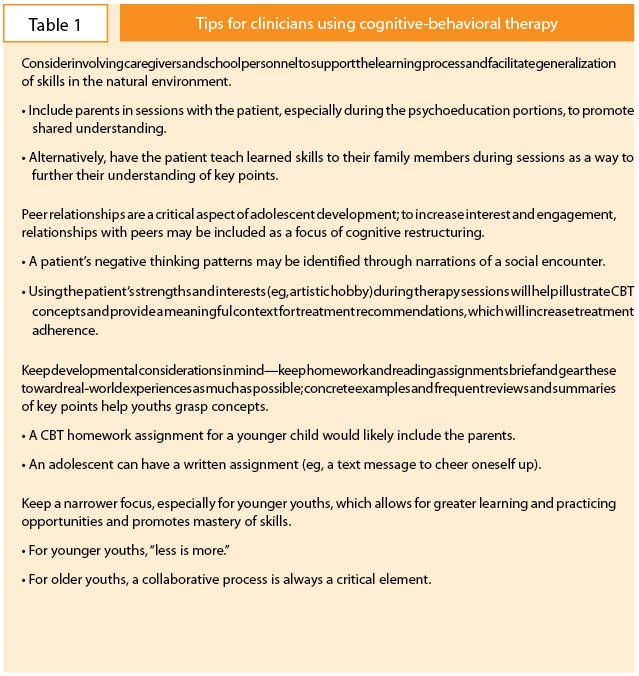
Table 2
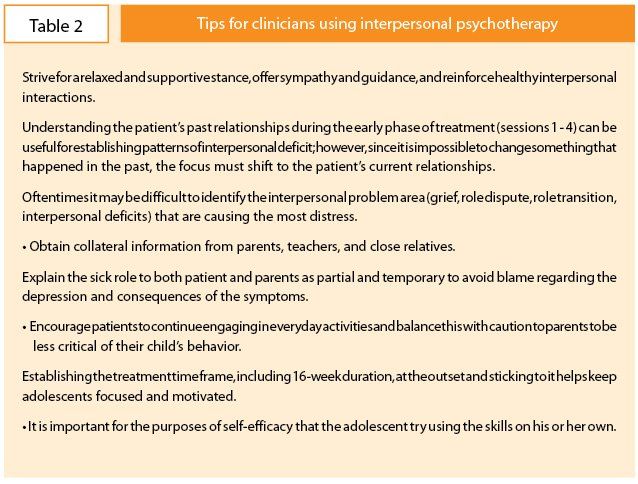
Table 3
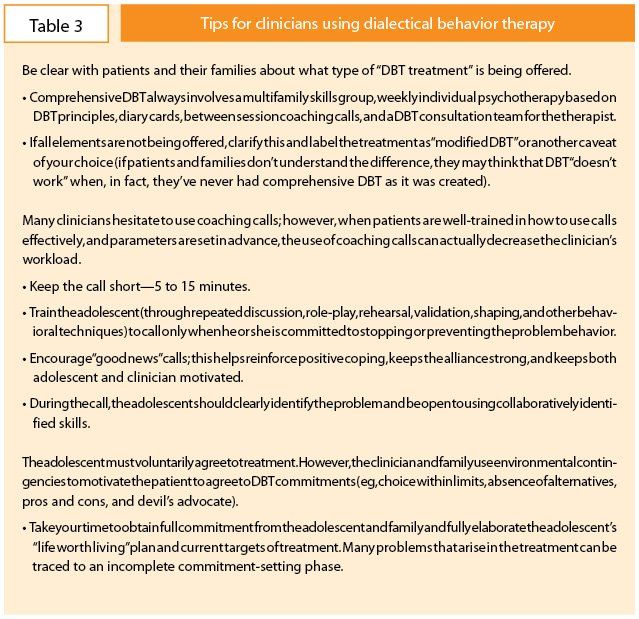
Adolescence is a time of increased vulnerability for depression, with risk factors driven by biological, cognitive, and social-environmental changes in development. More than half of all adolescents report experiencing depressed mood, and 8% to 10% experience clinically diagnosable symptoms.1 Depression in the young negatively affects all areas of development, including academic, cognitive, social, and family functioning, and if untreated, it can have significant lasting consequences.
Depression in adolescence is a strong predictor of recurrent depression in adulthood and long-term functional impairment, and it confers a 10-fold increase in risk for suicidal behavior.2 Clearly, depression is a significant health concern among youths, with the potential for severe and lasting consequences: the need for effective intervention is unambiguous.
Fortunately, there is strong empirical evidence for successful therapeutic treatment of adolescent mental health disorders, including depression. Psychotherapy for depression is as effective as medication in many cases and is the recommended first-line intervention for mild to moderate depression in youths. This article offers a brief review of the psychotherapeutic “three T’s” for depression: cognitive-behavioral therapy (CBT), interpersonal psychotherapy (IPT), and dialectical behavior therapy (DBT).
Cognitive-behavioral therapy
CBT is an evidence-based approach that has been tailored to treat a wide variety of mental health concerns in youths, including anxiety, eating disorders, impulse control disorders, ADHD, oppositional defiant disorder (ODD), and a range of other problematic behaviors in addition to specific adaptations for depression. Generally, CBT is directive, time-limited, structured, problem-focused, and goal-oriented. Weekly session structure begins with collaborative agenda setting and homework review and ends with review and consolidation of new skills learned and the assignment of new homework.
Related content: Treating Adolescent Depression With Psychotherapy: A Quiz
Treatment typically ranges from 4 to 20 sessions, depending on program choice and setting, although treatment of comorbid conditions or severe symptoms can take longer. Clinicians may use various combinations of CBT techniques, or they may adhere to a specific manualized program. Common CBT interventions include psychoeducation (helping the patient and parents understand the connection between thoughts, feelings, and behaviors), mood monitoring (keeping a mood diary, linking emotions to thoughts), pleasant activities (creating a list of activities that the patient enjoys and setting aside daily time to engage in them), behavior activation techniques (joining a sports team, going for nightly family walks), and cognitive restructuring (identifying cognitive distortions and negative thinking patterns and replacing them with more realistic and/or positive ways of thinking). Social, communication, conflict-resolution, and problem-solving skills are also frequent components of CBT programs.
CBT has an extensive research base and a longer history than either IPT or DBT; as such, the approach has traditionally been considered the gold standard for the treatment of childhood and adolescent depression. Meta-analyses in 1998 and 1999 found effect sizes for CBT treatment of depression in youths of 1.02 and 1.27 respectively.3,4 A more recent meta-analysis of 35 studies found a less pronounced effect size of 0.34, although this still represents a clinically significant small to medium treatment effect.5 On the basis of these findings, in 2008 CBT received status as a well-established treatment for youths, according to the guidelines set by Nathan and Gorman.6
In addition to comparisons with wait list control and treatment as usual (TAU), CBT has also been compared with psychopharmacological intervention, primarily SSRIs. One of the most cited and controversial studies is the multisite 2004 Treatment of Adolescent Depression Study (TADS).7 In this efficacy study, 439 depressed adolescents were treated with CBT, fluoxetine, a combination of the two, or a placebo. Results favored the combination of fluoxetine and CBT, followed by fluoxetine alone, and then CBT and placebo.
In contrast to existing findings, CBT was not found to be significantly more effective than placebo, and CBT’s effectiveness was questioned. However, supporters of CBT are quick to note mediating factors and design irregularities in the study. It remains noteworthy that the combination treatment in this study was most effective for depressed youths, particularly because of the potential of CBT to act as a buffer against negative life stress and suicide, which psychopharmacology alone may not address. In addition, later studies, such as the Treatment of SSRI-Resistant Depression in Adolescents (TORDIA), support the finding for combined CBT psychotherapy and medication in recalcitrant cases.8
The Practice Parameters of the American Academy of Child and Adolescent Psychiatry (AACAP) suggest that youths with mild depression may respond to CBT alone, whereas moderately to severely depressed youths may require CBT (or other psychotherapies) along with antidepressants. These guidelines also recommend that treatment continue for 6 to 12 months to avoid relapse.9
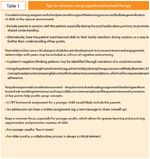
Tips for clinicians using cognitive-behavioral therapy
Many of the CBT programs for treatment of depression were developed initially in a group-delivery modality for research expediency. However, these programs can be tailored to the individual and applied within a variety of clinical settings, including outpatient, inpatient, schools, and partial hospitalization programs. CBT manuals range in level of directedness, from specific session by session instruction (Taking Action) to more principle-based manuals that guide the therapy and allow greater flexibility (Brent’s model within the Pittsburgh clinical trials).10-12 The level of parental involvement also varies across CBT approaches but is generally viewed as an important element and essential for children and younger adolescents (Table 1).
Interpersonal psychotherapy
IPT is a well-established, structured, time-limited therapy developed specifically for the treatment of nonbipolar, nonpsychotic major depression in adults. The original model was adapted for adolescents (IPT-A) by Mufson and colleagues13 in 1994. IPT-A defines the symptoms of depression and their consequences and the maintaining factors through an interpersonal lens, addressing problem areas in the adolescent’s current relationships and immediate social environments to reduce symptoms that contribute to depression.
IPT-A aims to improve communication and problem-solving skills to increase interpersonal effectiveness and relationship satisfaction in adolescents (aged 12 to 18 years). From a developmental psychopathology perspective, focus on interpersonal relationships is paramount during adolescence-a period in which more intimate peer and dating relationships are fostered and parent-child relationships undergo transitions based on adolescent autonomy development. IPT-A identifies 4 interpersonal problem areas that may become the focus of treatment: grief, role dispute, role transition, and interpersonal deficits. Through an interpersonal interview, working as a team, the therapist and patient identify 1 or 2 areas on which to focus.
Treatment is structured over 12 to 16 weeks in 60-minute sessions. The framework consists of 3 phases, in which the therapy aims to:
• Identify a specific interpersonal problem area by examining the patterns in current significant relationships
• Develop communication and problem-solving strategies to address the specific interpersonal problem area
• Practice the skills in session and then transition them to the social environment, providing the patient with support to maintain his or her sense of social competence and independence
Table 2
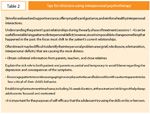
Tips for clinicians using interpersonal psychotherapy
During the initial stages, the therapist helps the patient and his family to understand the nature of the illness by assigning a limited sick role that emphasizes the disease model of depression and removes any blame (by self or by a parent). The therapist also uses a closeness circle to help the adolescent map the current connectedness of the significant relationships in his life and to identify those that he would like to deepen, distance, or change (Table 2).
IPT-A is a principle-driven approach with an active patient role. Thus, providers are offered a variety of helpful intervention techniques, but a particular intervention is not prescribed for each week. The selection of the specific techniques to use is driven by the early identification of the interpersonal problem area of focus.
The efficacy of IPT for depressive disorders has been well studied; there have been 38 randomized controlled trials. Five of these specifically examined an adolescent (versus adult) population. Studies that compared adolescents who received IPT-A with a control group (wait list control, clinical monitoring, TAU, CBT) yielded an estimated average effect size of 0.63 in meta-analysis.14 Adolescents who received IPT-A rather than clinical monitoring or TAU reported greater reduction in depressive symptoms posttreatment and greater increase in problem-solving skills and interpersonal functioning at 16-week follow-up.
Several international studies examined the efficacy of IPT-A with Ugandan, Taiwanese, and Puerto Rican adolescents.15-17 These studies yielded similar results, suggesting that IPT-A is as effective as CBT in reducing depressogenic symptoms, including decreases in depressed mood, suicidal ideation, hopelessness, and anxiety. Both IPT-A and CBT were found to be more effective than the wait list control at posttreatment and 3-month follow-up assessments.14-16 However, IPT-A appears to have a supplementary effect on adolescents in that it also increased overall social functioning, self-esteem, and problem-solving skills, which may act as protective factors against relapse.17,18
Although these studies shed light on the efficacy of IPT-A, the treatment has yet to be compared with pharmacotherapy in an adolescent population. The NIMH did, however, conduct a study in which IPT was found to be as effective as imipramine in the treatment of MDD in adults.19
Dialectical behavior therapy
DBT was developed by Linehan20 in the early 1990s. It is based on her extensive clinical and research experience in treating chronically suicidal women. The approach was originally aimed at treating borderline personality disorder (BPD), of which chronic suicidality is a major feature. Adaptations to adolescent populations (DBT-A) were made in 2002 by Rathus and Miller,21 eventually culminating in a manual for adolescents in 2007.22
Although experts have suggested that BPD can be meaningfully diagnosed in adolescents, historically, personality disorders were not diagnosed in persons younger than 18. Thus, DBT for adolescents (DBT-A) was targeted specifically at suicidality, as opposed to BPD. However, in defining their criteria for admittance, specific DBT-A programs may seek to identify adolescents with multiple problem behaviors (mood symptoms, self-harm, substance abuse, eating disorder, risky sexual behavior, high-risk activities, and problem behaviors such as stealing and lying) of which suicidality or parasuicidal and self-injurious behavior are prominent. Some programs require the adolescent to meet at least 3 or 4 of the BPD criteria for inclusion.22
Table 3
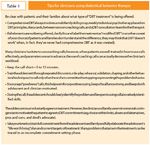
Tips for clinicians using dialectical behavior therapy
The DBT model is predominantly a behavioral one; however, this underlying theoretical approach is melded with Zen mindfulness principles to create a dialectic that simultaneously emphasizes acceptance of the patient in his current state and a willingness to continually work to change and improve. The treatment approach targets 5 functions: enhancing patient capabilities, increasing motivation, structuring the environment to increase the likelihood of success, promoting generalization from therapy to the natural environment, and enhancing therapists’ capabilities and motivation to treat patients effectively (Table 3).
These functions are addressed through 4 modes of treatment: multifamily group skills training, individual psychotherapy, coaching calls, and a consultation team for the therapist. The approach is a “life enhancement” as opposed to suicide prevention program. Thus, if an adolescent can be helped to envision and work toward an obtainable, truly exciting life, then suicide no longer becomes a logical “solution” to the adolescent’s problems. The adolescent’s presenting problems (target behaviors) are behaviorally defined and logically identified as barriers to his self-defined “life worth living.”
Skills training is founded on evidence that patients who present with chronic suicidality lack certain coping skills for soothing and regulating themselves during times of high stress and emotion. The skills taught encompass 5 areas, 4 original to DBT and the fifth added for the adolescent adaptation: mindfulness, distress tolerance, emotion regulation, interpersonal effectiveness, and walking the middle path (adolescent-specific).20,22
Although the structure of skills training is specific, individual DBT sessions are principle- rather than protocol-driven-the clinician is given a toolbox of techniques and a road map based on DBT principles and the patient’s treatment goals and target behaviors. This allows treatment to stay cohesive in the face of a patient population that typically is under a great deal of stress and distress, with multiple problems otherwise resulting in the challenge to treatment of an ever-moving target with “crises du jour” threatening to derail treatment gains. By keeping a principle-driven approach, the therapist and adolescent are able to incorporate the important events of the week into overarching treatment goals without losing momentum or focus.
Goals in DBT follow a hierarchy, with life-interfering behaviors taking precedent, followed by behaviors that interfere with or threaten treatment, quality-of-life–interfering behaviors, and finally skills enhancement. A full description of DBT techniques is beyond the scope of this article, but additional information can be found in primary texts and summary articles.20,22-24
DBT is a well-established treatment for adults with BPD, with more than 7 randomized controlled trials (RCTs).23,24 To date no RCTs of DBT-A have been published. However, DBT-A has been examined in several open trials and quasiexperimental designs, with encouraging findings. Rathus and Miller21 conducted the initial validity study, comparing DBT with TAU in a nonrandomized study of 111 outpatient adolescents with BPD features, including current suicidal ideation or parasuicidal behavior. Adolescents who received DBT were significantly more likely to complete treatment and had fewer psychiatric hospitalizations (0% vs 13%). There were no significant differences in parasuicidal behaviors, although it is important to note that those with parasuicidal behavior were specifically recruited to the DBT treatment; differences in suicide attempt (1 vs 7) were nonsignificant.
Several smaller pilot studies of nonrandomized adolescents have been conducted using pre-post designs. They compared DBT-A or elements of DBT-A with TAU. Adolescents with nonsuicidal self-injury and other BPD features were treated with DBT or TAU in residential, hospital, and outpatient clinic settings. In each case, adolescents who received DBT evidenced greater reduction of symptoms, such as mood and self-injurious behavior, and evidenced improved relationships and overall functioning.23,25 However, the DBT-A approach awaits randomized controlled trial data, and for this reason, it cannot be designated well-established for adolescents at this time.
Summary
Despite the high prevalence of depression among youths, there are empirically supported treatments that have been shown to reduce depressogenic symptoms, including the 3 therapies outlined in this article. When deciding which treatment to employ, the clinical needs of the youth, such as cognitive capabilities, behavioral issues, interpersonal strengths and weaknesses, and suicidality level, should be taken into account.
Psychotherapy Training Resources
Cognitive-behavioral therapy
•Association for Behavioral and Cognitive Therapies: training and certification programs can be found on the ABCT Web site: www.abct.org
•A directory of certified therapists is available at http://www.abct.org/Members/?m=FindTherapist&fa=FT_Form&nol
Interpersonal psychotherapy
•Interpersonal Psychotherapy Institute: certification includes supervision by a certified IPT supervisor for 2 IPT cases. http://iptinstitute.com/ipt-certification-process
•A directory of certified therapists is available at http://iptinstitute.com/find-a-member-ipt-therapist
Dialectical behavior therapy
•Behavioral Tech, LLC: development of a certification process is under way; currently the highest level is Intensive Training (10-day workshop) requiring participants to register as a DBT Team of 4 or more persons (teams can be loosely defined and may not practice in the same setting): http://behavioraltech.org/training
•A directory of Intensive Training therapists is available at http://behavioraltech.org/resources/crd.cfm
Editor’s Note: Our Category 1 CME articles will return shortly. In the meantime, we invite you to test yourself: read the article, take the posttest on the next page, and then check the answer key on the last page.
1. Depression in adolescence is a strong predictor of recurrent depression in adulthood and long-term functional impairment, and it confers a 20-fold increase in risk for suicidal behavior.
A. True
B. False
2. Which of the following components is a core element of cognitive-behavioral therapy (CBT)?
A. Mindfulness
B. Mood monitoring
C. Closeness circle to define interpersonal relationships
D. Assigning a limited sick role
3. Which of the following is considered to be the gold standard in treating childhood and adolescent depression?
A. Psychodynamic therapy
B. Family therapy
C. CBT
D. Dialectical behavior therapy (DBT)
4. In the Treatment of Adolescent Depression Study, which of the following interventions was most efficacious?
A. A combination of fluoxetine and CBT
B. Fluoxetine alone
C. A combination of placebo and CBT
D. CBT alone
5. The primary focus of DBT is addressing problem areas in the adolescent’s current relationships and immediate social environments in order to reduce symptoms that contribute to depression.
A. True
B. False
6. Which of the following is a problem area that might become the focus of interpersonal psychotherapy (IPT)?
A. Grief
B. Role dispute
C. Role transition
D. Interpersonal deficits
E. All of the above
7. There are ___ phases in IPT?
A. 3
B. 5
C. 6
8. DBT for adolescents is targeted specifically to borderline personality disorder.
A. True
B. False
9. The primary “dialectic” in DBT is the integration of:
A. Psychotherapy and psychopharmacology
B. Interpersonal and individual difficulties
C. Acceptance and change
D. Skills training and individual sessions
10. Individual DBT sessions are protocol-driven.
A. True
B. False
Answer key to the Mine Your Mind posttest:
1B, 2B, 3C, 4A, 5B, 6E, 7A, 8B, 9C, 10B
References:
References
1. Shaffer D, Fisher P, Dulcan MK, et al. The NIMH Diagnostic Interview Schedule for Children Version 2.3 (DISC-2.3): description, acceptability, prevalence rates, and performance in the MECA Study. Methods for the Epidemiology of Child and Adolescent Mental Disorders Study. J Am Acad Child Adolesc Psychiatry. 1996;35:865-877.
2. Berman A, Jobes D, Silverman M. Adolescent Suicide: Assessment and Intervention. 2nd ed. Washington, DC: American Psychological Association; 2006.
3. Reinecke MA, Ryan NE, DuBois DL. Cognitive-behavioral therapy for depression and depressive symptoms during adolescence: a review and meta-analysis. J Am Acad Child Adolesc Psychiatry. 1998;37:26-34.
4. Lewinsohn PM, Clarke GN. Psychosocial treatments for adolescent depression. Clin Psychol Rev. 1999;19:329-342.
5. Weisz J, McCarty C, Valeri S. Effects of psychotherapy for depression in children and adolescents: a meta-analysis. Psychol Bull. 2006;132:132-149.
6. Nathan PE, Gorman JM, eds. A Guide to Treatments That Work. 2nd ed. New York: Oxford University Press; 2002.
7. March J, Silva S, Petrycki S, et al; Treatment for Adolescents With Depression Study (TADS) Team. Fluoxetine, cognitive-behavioral therapy, and their combination for adolescents with depression: Treatment for Adolescents With Depression Study (TADS) randomized controlled trial. JAMA. 2004;292:807-820.
8. Brent D, Emslie G, Clarke G, et al. Switching to another SSRI or to venlafaxine with or without cognitive behavioral therapy for adolescents with SSRI-resistant depression: the TORDIA randomized controlled trial. JAMA. 2008;299:901-913.
9. Birmaher B, Brent D; AACAP Work Group on Quality Issues. Practice parameter for the assessment and treatment of children and adolescents with depressive disorders. J Am Acad Child Adolesc Psychiatry. 2007;46:1503-1526.
10. Stark KD, Streusand W, Krumholz LS, Patel P. Cognitive-behavioral therapy for depression: The ACTION treatment program for girls. In: Weisz JR, Kazdin AE, eds. Evidence-Based Psychotherapies for Children and Adolescents. 2nd ed. New York: Guilford Press; 2010:93-109.
11. Stark KD, Simpson J, Schnoebelen S, et al. Therapist’s Manual for ACTION. Broadmore, PA: Workbook; 2004.
12. Brent DA, Holder D, Kolko D, et al. A clinical psychotherapy trial for adolescent depression comparing cognitive, family, and supportive therapy. Arch Gen Psychiatry. 1997;54:877-885.
13. Mufson L, Moreau D, Weissman MM, et al. Modification of interpersonal psychotherapy with depressed adolescence (IPT-A): phase I and phase II studies. J Am Acad Child Adolesc Psychiatry. 1994;33:695-705.
14. Cuijpers P, Geraedts AS, van Oppen P, et al. Interpersonal psychotherapy for depression: a meta-analysis [published correction appears in Am J Psychiatry. 2011;168:652]. Am J Psychiatry. 2011;168:581-592.
15. Rosselló J, Bernal G. The efficacy of cognitive-behavioral and interpersonal treatments for depression in Puerto Rican adolescents. J Consult Clin Psychol. 1999;67:734-745.
16. Tang TC, Jou SH, Ko CH, et al. Randomized study of school-based intensive interpersonal psychotherapy for depressed adolescents with suicidal risk and parasuicide behaviors. Psychiatry Clin Neurosci. 2009;63:463-470.
17. Bolton P, Bass J, Betancourt T, et al. Interventions for depression symptoms among adolescent survivors of war and displacement in northern Uganda: a randomized controlled trial. JAMA. 2007;298:519-527.
18. de Mello MF, de Jesus Mari J, Bacaltchuk J, et al. A systematic review of research findings on the efficacy of interpersonal therapy for depressive disorders. Eur Arch Psychiatry Clin Neurosci. 2005;255:75-82.
19. Elkin I, Shea MT, Watkins JT, et al. National Institute of Mental Health Treatment of Depression Collaborative Research Program. General effectiveness of treatments. Arch Gen Psychiatry. 1989;46:971-982.
20. Linehan MM. Cognitive-Behavioral Treatment of Borderline Personality Disorder. New York: Guilford Press; 1993.
21. Rathus JH, Miller AL. Dialectical behavior therapy adapted for suicidal adolescents. Suicide Life Threat Behav. 2002;32:146-157.
22. Miller AL, Rathus JH, Linehan MM. Dialectical Behavior Therapy With Suicidal Adolescents. New York: Guilford Press; 2007.
23. Salsman NL, Arthur R. Adapting dialectical behavior therapy for suicidal adolescents. Curr Psychiatry. 2011;10:18-23.
24. Lynch TR, Chapman AL, Rosenthal MZ, et al. Mechanisms of change in dialectical behavior therapy: theoretical and empirical observations. J Clin Psychol. 2006;62:459-480.
25. Fleischhaker C, Böhme R, Sixt B, et al. Dialectical behavior therapy for adolescents (DBT-A): a clinical trial for patients with suicidal and self-injurious behavior and borderline symptoms with a one-year follow-up. Child Adolesc Psychiatry Ment Health. 2011;5:3.






